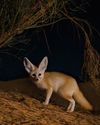HOPPING BACK
BBC Wildlife
|Spring 2022
Citizen science is reversing the fortunes of the UK’s largest grasshopper

You don’t get a lot of wildlife on the London Underground: rats and mice scurrying along the tracks; dogs sitting obediently at their owners’ feet; pigeons, perhaps, on the open air stretches of the network. That’s about it.
Yet on 18th July last year, Amy Stocking, a librarian from Claygate, Surrey, found herself in a busy tube carriage with some rather more unusual animals. In her bag that day were about 20 large marsh grasshoppers, insects that she had hatched and spent weeks rearing as a volunteer keeper with Citizen Zoo, a social enterprise dedicated to conservation and rewilding.
In just five weeks, the hoppers had gone from tiny nymphs (“when they first hatch they’re like little specks”) to fully grown adults, ready to be released into a restored area of their former habitat from which the species had been absent for over 50 years.
“When they’re adults, they stridulate,” says Stocking, referring to the characteristic mating sound that grasshoppers make by hitting a back leg against a forewing. “There I was on the tube with all these hoppers, chirping away.”
LARGE MARSH GRASSHOPPERS, AS their name suggests, are the largest of the UK's 11 native species. The females measure up to about 4cm long and weigh three times the mass of their biggest cousins. They are also, sadly, among our rarest - victims of habitat degradation resulting from changing land use in East Anglia, including the Fens, a large area of historically marshy, low-lying land stretching across Cambridgeshire and Norfolk.
“The Fens were almost certainly heaving with large marsh grasshoppers 300 years ago,” says Stuart Green, lead entomologist for Citizen Zoo and a grasshopper specialist.
Denne historien er fra Spring 2022-utgaven av BBC Wildlife.
Abonner på Magzter GOLD for å få tilgang til tusenvis av kuraterte premiumhistorier og over 9000 magasiner og aviser.
Allerede abonnent? Logg på
FLERE HISTORIER FRA BBC Wildlife

BBC Wildlife
"I was terrified the elephant would ram us"
African elephant in Kenya
2 mins
January 2026

BBC Wildlife
ALL YOU EVER NEEDED TO KNOW ABOUT THE Fennec fox
THE FENNEC FOX IS THE SMALLEST fox in the world, with a body length that can be as little as 24cm.
3 mins
January 2026

BBC Wildlife
INTO THE PLASTISPHERE
A unique synthetic ecosystem is evolving in our oceans – welcome to the plastisphere
7 mins
January 2026

BBC Wildlife
“More than half of all animal life exists in a parasitic relationship, and all life lives in symbiosis”
Our survival depends on species evolving to live together - but some relationships take dark turns
7 mins
January 2026

BBC Wildlife
Are animals able to dream?
SLEEP IS A MYSTERIOUS THING. FOR A long time, we weren't sure why we do it.
1 mins
January 2026

BBC Wildlife
Does a cuckoo know it's a cuckoo?
ABSURD LITTLE BIRDS ACROSS THE world lay their eggs in the nests of other species, leaving the hapless parents to raise a changeling at the expense of their own offspring.
2 mins
January 2026

BBC Wildlife
Orcas killing young sharks
Juvenile great whites are easy prey for orca pod
1 mins
January 2026

BBC Wildlife
Ocean goes on tour
Acclaimed film touring the UK, backed by live orchestra and choir
1 min
January 2026

BBC Wildlife
Feisty bats hunt like lions
Winged mammals use a 'hang and wait' strategy to take down large prey
1 mins
January 2026

BBC Wildlife
SNAP-CHAT
Richard Birchett on magical merlins, wily coyotes and charging deer
2 mins
January 2026
Translate
Change font size

